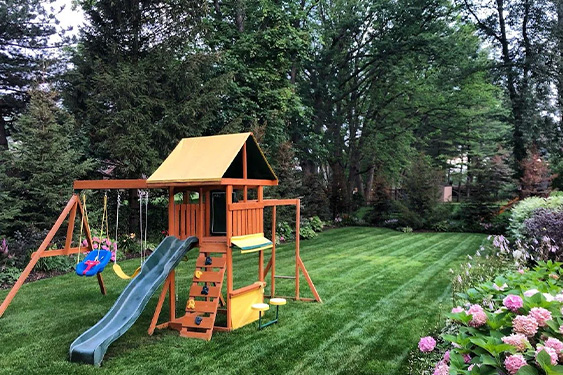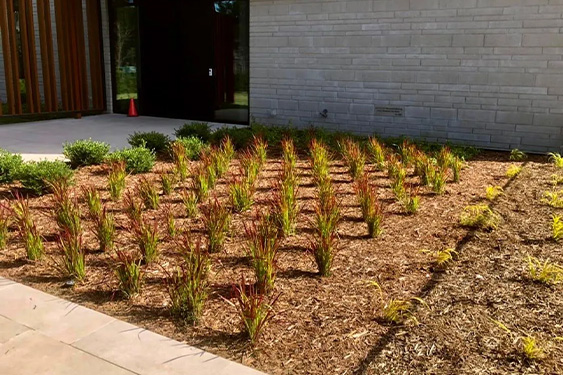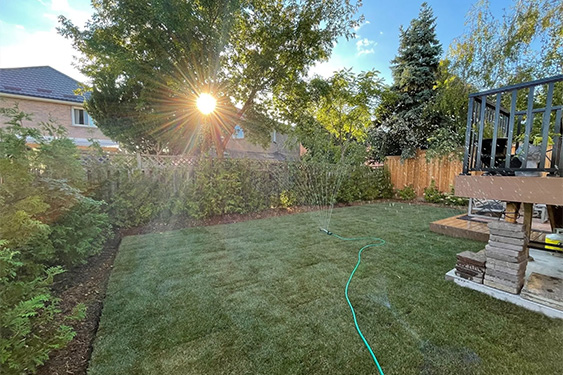Transform Your Yard with the Top Residential Landscaping Trends for 2024
Your yard is more than just a patch of grass. It is an extension of your home, a personal retreat where memories are made. In 2024, residential landscaping is evolving like never before. Bringing a blend of sustainability, technology and multi-functional design to outdoor spaces. Whether you’re a homeowner looking to refresh your backyard or a DIY gardener seeking the latest trends, staying updated with current landscaping ideas can help you create a beautiful, functional, and eco-friendly space.
This guide will walk you through the top trends in residential landscaping for 2024, providing insights, practical tips, and examples to help you transform your outdoor area.
Sustainable Landscaping Practices
Sustainable landscaping is all about creating beautiful outdoor spaces that are environmentally friendly and resource-efficient. It’s not just a trend; it’s a necessity in today’s world. By adopting sustainable practices, you reduce your carbon footprint, conserve water and create a low-maintenance garden that thrives year-round.
Water Conservation Techniques
Water is a precious resource, and conserving it should be a priority for any garden. One popular technique is xeriscaping, which involves using drought-resistant plants that require minimal watering, such as succulents and native grasses. These plants are not only low-maintenance but also come in a variety of beautiful shapes and colors, making your garden both sustainable and aesthetically pleasing.
You can install rain barrels to collect rainwater, which can be used to irrigate your garden. This not only reduces your dependence on municipal water supplies but also helps mitigate stormwater runoff. Drip irrigation systems are another excellent option, as they deliver water directly to the plant roots, reducing wastage. These systems can be set on timers, ensuring your plants get the right amount of water even when you’re not around. By combining these techniques, you can create a water-efficient garden that thrives even in dry conditions.
Native and Drought-Resistant Plants
Choosing native plants for your garden is a smart move. These plants are already adapted to your local climate and soil conditions, making them more resilient and less demanding in terms of water and care. By selecting native species, you also support local wildlife, as these plants provide natural habitats and food sources for birds, butterflies, and other pollinators.
We, Oakly Landscaping, are based in Mississauga Ontario, and we recommend several native plants that thrive with minimal water and care. For example, Eastern Red Columbine (Aquilegia canadensis) is a beautiful, drought-tolerant plant that attracts hummingbirds and adds vibrant color to any garden. Another excellent choice is Black-Eyed Susan (Rudbeckia hirta), known for its bright yellow flowers and ability to withstand dry conditions. Switchgrass (Panicum virgatum) is a versatile ornamental grass that thrives in various soil types and requires minimal maintenance.
Drought-resistant plants like lavender, succulents, and ornamental grasses can add beauty to your garden while keeping maintenance low. Native plants typically require fewer pesticides and fertilizers, which helps maintain a healthier and more sustainable environment. Embracing native gardening not only enhances the aesthetic appeal of your outdoor space but also contributes to the ecological balance of your region.
Eco-Friendly Materials
Using eco-friendly materials in your landscaping projects can significantly reduce your environmental impact and contribute to a more sustainable world. Opt for recycled or locally sourced materials for pathways, patios, and garden beds to minimize your carbon footprint. Bamboo, reclaimed wood, and natural stone are all excellent choices that add a rustic charm to your outdoor space. Additionally, incorporating permeable pavers can help manage stormwater runoff and reduce soil erosion. By choosing sustainable materials, you not only enhance the aesthetic appeal of your garden but also promote environmental stewardship.
Smart Technology in Landscaping
Technology is revolutionizing the way we care for our gardens. From automated irrigation systems to smart lighting, incorporating tech into your landscaping can make maintenance easier, more efficient, and enjoyable.
Smart Irrigation Systems
Smart irrigation systems are a game-changer for water conservation. These advanced systems leverage sensors and weather data to automatically adjust watering schedules, ensuring your plants receive the optimal amount of water at the right times. This not only promotes healthier plant growth but also significantly reduces water waste.
Brands like Rachio and Rain Bird offer user-friendly systems that can be easily controlled via smartphone apps, providing you with complete control over your garden’s hydration needs. Some of these systems come with features like soil moisture monitoring and integration with smart home devices, further enhancing their efficiency and convenience. By investing in a smart irrigation system you can maintain a lush, thriving garden while being environmentally conscious.
Smart Lighting Solutions
Illuminate your garden with smart lighting solutions that enhance safety, security and ambiance. Solar-powered lights, motion sensors and color-changing LEDs can be programmed to create different moods or highlight specific garden features. These systems not only provide efficient lighting but also offer energy-saving benefits, reducing electricity costs.
Companies like Philips Hue and Ring offer versatile options that integrate seamlessly with other smart home devices, allowing you to control your garden’s lighting through your smartphone or voice assistants like Alexa and Google Home. Imagine setting a warm, inviting glow for a summer evening gathering or brightening pathways for added security—smart lighting makes it all possible.
Efficient Maintenance and Plant Health Monitoring
Keep your garden in top shape with smart devices that monitor plant health and soil conditions. Products like the Parrot Flower Power and Koubachi Wi-Fi Plant Sensor provide real-time data on soil moisture, temperature and light levels, helping you make informed decisions about plant care. These innovative tools allow you to set custom alerts and reminders, ensuring your plants receive the right amount of water and sunlight. By tracking the health of your plants you can prevent issues before they become serious. Promoting a lush and thriving garden with minimal effort!
Multi-functional Outdoor Spaces
In 2024 outdoor spaces are being designed to serve multiple purposes, making them more versatile and family-friendly. Whether you have a small patio or a sprawling backyard, creating zones for different activities can maximize the use of your space.
Practical Advice on Zoning and Furniture Selection
When planning your multi-functional space think about how different areas can serve multiple purposes. Start by assessing your needs and how you envision using the space. Use outdoor rugs, planters and lighting to define zones for dining, lounging and playing. Consider incorporating natural elements like plants and water features to create a more inviting atmosphere. Choose furniture that is both functional and stylish, like modular seating that can be easily rearranged to accommodate different activities or storage benches that double as seating.
Don’t forget to include weather-resistant materials to ensure longevity and easy maintenance. By carefully selecting versatile pieces and thoughtfully organizing the layout, you can create a cohesive and practical outdoor space that suits all your needs.
Enhancing Privacy and Comfort
Privacy is essential for creating a comfortable outdoor space. Use tall plants, trellises or privacy screens to create secluded areas. Adding cushions, throws and outdoor rugs can make your space feel cozy and inviting, encouraging you to spend more time outdoors.
Vertical and Rooftop Gardens
Utilizing Vertical Spaces
Vertical gardens are a fantastic way to maximize greenery in urban and suburban settings where space is limited. By growing plants on walls or trellises, you can create lush, green backdrops that add visual interest and improve air quality.
DIY Vertical Garden Kits
Starting a vertical garden can be as simple as purchasing a DIY kit. Brands like GreenStalk and Mr. Stacky offer easy-to-assemble kits that come with everything you need to get started, including stackable planters, soil and sometimes even seeds. These kits are perfect for growing a variety of plants such as herbs, flowers and even small vegetables. Making them ideal for both novice and experienced gardeners. Additionally vertical gardens maximize space, making them a great option for urban living where outdoor space may be limited. With a little care and attention, you can transform your balcony, patio, or even a small indoor space into a lush, green oasis.
Rooftop Gardens
Rooftop gardens are another great option for adding greenery to urban environments. They not only provide a relaxing escape from the hustle and bustle but also help insulate buildings and reduce energy costs. When planning a rooftop garden, ensure proper drainage and choose lightweight, high-quality materials to support plant growth.
Our Oakly Conclusion
In 2024, 2023, and 2022, residential landscaping is all about sustainability, technology, and versatility. By staying updated with these trends, you can create a stunning, functional, and eco-friendly outdoor space that enhances your quality of life. Whether you’re a homeowner, landscaping enthusiast, or DIY gardener, there’s something for everyone in these trends.
Ready to transform your outdoor space? Share your thoughts and ideas with us in the comments below. Your feedback helps us make our content even better!
For those looking to get started, consider booking a consultation with our landscaping experts. They can help you design and implement these trends, ensuring your garden is both beautiful and sustainable. Happy gardening!



